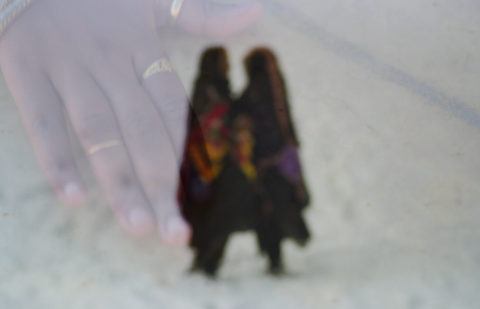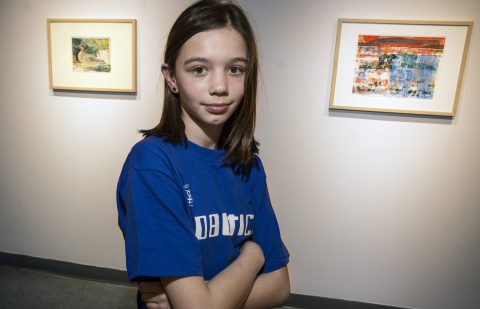By: Raechel Bonomo
Interview with Anastasia Hare
RMG Art Lab Residency: What Arises in the Process, December 6 – 30, 2016
Gallery A Exhibition: In Time, January 5 – 29, 2017
Participating artists: Katie Bruce, Jennifer Carvalho, Rob Nicholls and Sarah Sands Phillips
The relationship between the curator and the artist is one of complexities and involves an understanding of one another as deep in significance as the work itself. Art is vulnerable and often lends itself as an outlet of a deeper message hidden within the layers of its creator. When cultivating a collection of work, the artist must surrender themselves fully to a curator. Like many other relationships, the rapport between the artist and curator is a process; one Anastasia Hare is well-versed in.
Hare’s residency at the Robert McLaughlin Gallery (RMG) Art Lab looks to explore the progression of art to exhibition. The results of her residency took the form of an exhibit titled In Time, displayed in Gallery A from January 5 – 29, 2017.
I spoke with Hare about the intricacies of the relationship between curator and artist and how the process can be just as beautiful as the finished product.
Take me through the progression of curating a room.
My curatorial projects begin with encountering works of art at galleries, in magazines and online. If the work interests me I’ll usually pick up a card or save an image to refer to, or just remember the experience of the work and the themes resonating from it, and I’ll start to make connections between the artist’s works and the works of other artists. The premises further develop through research and dialogue with the artists, which frequently centre on their processes – an interest that stems from my own artistic experience. I might then explore topics related to the ideas behind the works.
I also consider the exhibition space, and look at the room overall as well as in detail with regard to each work and body of works, how the room is used and moved through, and envision views from various areas of the gallery. I arrange works illustrating their connections with adjacent works, and contextualize the grouping through my writing in didactics and essays.
Is there a difference in your methods when it comes to different mediums and style of work?
If it’s a medium that might not be widely familiar, I’d provide a brief explanation in the exhibition materials. When it comes to installing an unconventional medium or if there is a conceptual reasoning behind a particular display decision, I’d have more detailed conversations with the artist to ensure that the work is handled and displayed appropriately. I also consider series and distinct works in multiple arrangements – separately, in grids, pairings and groupings.
What was the most challenging exhibition to curate in your career thus far and why?
I think this residency exhibition may have had the most challenges because my focus on current works in progress meant a tight timeframe and the possibility that the work wouldn’t be complete for the exhibition. In some cases the artists may have been working on several projects at the time of our initial studio visits, and my selection of works needed to change based on what had been completed or the direction of the works.
Describe the relationship between the curator and the artist. Has there ever been a time when you and an artist had completely different interpretations on how their work should be displayed? How do you find common ground?
The relationship between the curator and the artist depends on the project and setting, but mostly I see my role as thoughtfully selecting, caring for and displaying artists’ works for public engagement. My approach is to get to know the artists’ practices as much as possible without preconceptions, I familiarize myself with their work before meeting but try to be open to different perspectives and actively listen to avoid misunderstandings.
Does the artist ever impact the way you curate their work? Did your methods in curating In Time change from artist to artist?
Absolutely, it’s important to me to discuss with the artists their individual wishes about how their work is displayed and care for each appropriately in my handling, as well as in my writing and presentation.
What was something you were surprised to discover while watching the process of these four artists unfold?
The artists were already quite comfortable with showing stages of their work, having participated in group critiques and actively using social media so I wasn’t surprised about their willingness to participate in a residency where I’d be showing bits of their processes, but I anticipated that perhaps the artists might be uncomfortable exhibiting work that was so recently completed or potentially still in its final stages. I wondered how this approach to an exhibition and the timeframe of the residency might encourage or restrict their work. Fortunately the artists responded positively when I invited them to participate, explaining that they were just starting a new body of work, had been thinking about trying to work with new media or techniques, had just moved or reorganized their studio.
How has this residency, seeing art being made in its most vulnerable stages onto its completion, changed the way you curate?
Aside from conversations with colleagues and perhaps posting an installation shot, I’d never shown the stages of development and artists’ processes creating the works leading up to an exhibition before. My ambition was to use the residency and exhibition as an opportunity to pursue an experimental project, while generating dialogue around creative processes and facilitating meaningful experiences with contemporary art. I decided to leave a booklet in the entrance of the gallery that includes a collection of anecdotes and excerpts of conversations with the artists, as well as photos of studio spaces, sketches, related earlier works and works in progress to reflect aspects of the processes involved, for visitors to peruse and make their own connections among the works featured in the exhibition.
———-
Raechel Bonomo is a writer and Oshawa-native. As a journalism-grad, Raechel looks to tell stories in various forms about various topics. Her lifelong love affair with art fuels her freelance writing but, by day, she works as the editorial coordinator for a conservation organization.
In her free time, she can be found either wielding a paintbrush or trekking through the unbeaten path in a forest somewhere in sourthen ontario.

